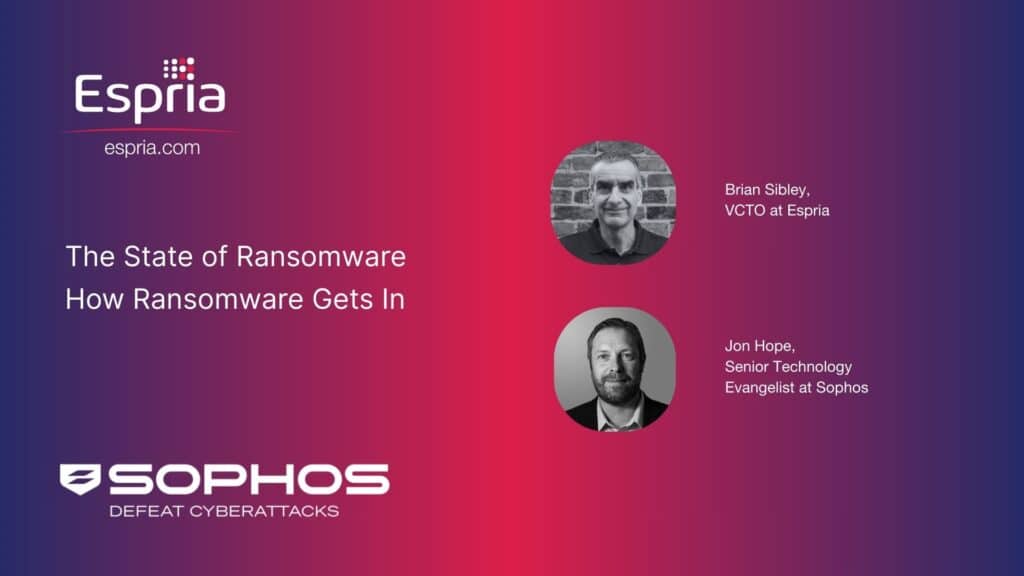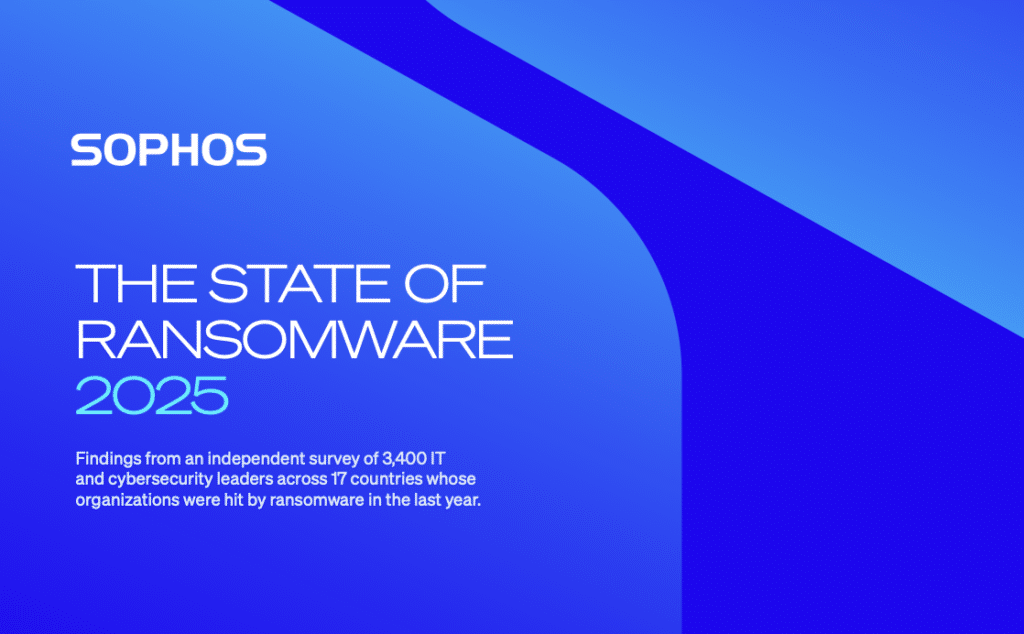Behind the Breach: How Ransomware Gets In

In the second of our of State of Ransomware series with Sophos, Brian Sibley, VCTO at Espria and Jon Hope, Cyber Security Evangelist at Sophos talk about what goes on behind the breach and how ransomware gets in.
In this episode the team explore the major technical and operational root causes that lead to ransomware incidents in the UK, why exploited vulnerabilities are the leading technical cause and what preventative strategies you can put in place. Don’t let your business become a statistic in the next State of Ransomware report.
This podcast episode delves into ransomware, exploring how it infiltrates organisations, its root causes, and the defence strategies for prevention. The discussion highlights the complexity of ransomware attacks, emphasising both technological vulnerabilities and human factors.
Ransomware attacks stem from multiple factors, with the most common cause being exploited vulnerabilities in software, accounting for approximately 32% of successful attacks. These vulnerabilities arise from known software flaws that cybercriminals exploit, often due to inadequate or delayed patching by organisations, influenced by limitations in resources and skills.
Human factors also play a significant role. Compromised credentials, often a result of social engineering tactics like fake help desk calls or fraudulent websites, represent another major vector. These attacks are difficult to detect because stolen credentials enable cybercriminals to log in legitimately, making the intrusion hard to distinguish from genuine user activity.
Phishing and malicious emails further contribute to ransomware entry points. These require user interaction and are becoming increasingly sophisticated due to the use of artificial intelligence (AI) by attackers. AI enables cybercriminals to craft convincing emails that mimic trusted brands, using appropriate language and branding to deceive recipients.
Despite awareness, organisations often struggle with vulnerability management due to operational challenges such as a lack of skilled personnel, insufficient time, and security gaps. Ransomware attacks can also expose previously unrecognised weaknesses within an organisation’s security posture.
Detection technologies face difficulties, particularly with attacks involving stolen credentials and sophisticated phishing. Logs generated by network devices contain valuable information about attack chains, including unauthorised access, lateral movement, data exfiltration, and file encryption. However, interpreting these logs requires skilled threat hunters and continuous monitoring, which many organisations lack due to resource constraints.
Platforms like Extended Detection and Response (XDR) and Security Information and Event Management (SIEM) systems help consolidate logs for analysis, but human expertise remains crucial to identify and respond to threats effectively. Managed Detection and Response (MDR) services offer a practical solution by providing round-the-clock monitoring and expert analysis without requiring organisations to hire full-time specialists.
The discussion underscores the value of human-led threat hunting combined with integrated security tools that provide a holistic view of an organisation’s security posture. Effective protection relies not only on endpoint security but also on data from various sources, including email systems and backup solutions.
Recovery planning, visibility into the IT estate, and early warning systems are critical components of a resilient cybersecurity strategy. Organisations should strive to detect and stop attacks before damage occurs, as recovery, while improving, is a last resort.
This podcast episode offers a comprehensive overview of ransomware infiltration methods, highlighting the interplay of technological vulnerabilities and human factors. It stresses the need for timely patching, user education, advanced detection technologies and human expertise in threat hunting.
You may be interested in
The Current Threat Landscape
In the past year, 71% of secondary schools have reported a breach or attack – cyber-attacks are constantly making headlines. In episode 2 of our podcast series our team of experts discuss the evolving threat landscape. You will learn The Espria and Mimecast team also share proactive strategies to enhance your organisation’s cyber security. With budgetary restrictions impacting many education establishments, they often lack the in-house resources to manage their cyber security effectively. The constant monitoring of data, looking for patterns and vulnerabilities to detect and respond to cyber threats is simply not an option…
The 2025 State of Ransomware: Key Insights on Attacks, Costs, and Recovery
Ransomware continues to evolve — and so must our defenses. The State of Ransomware 2025 report from Sophos presents one of the most comprehensive views yet into how organisations around the world are being impacted by ransomware attacks. Based on an independent survey of 3,400 IT and cybersecurity leaders across 17 countries, the report explores how attacks are evolving, the operational weaknesses adversaries exploit, and the human and financial tolls that follow. Whether you’re building a cybersecurity strategy or assessing risk, this year’s findings offer crucial, real-world insights to guide your response. Key Findings from…
Outgrowing your MSP; businesses need a provider that scales with their growth
To stay competitive, business leaders must align with MSPs that deliver strategic value, drive innovation, and support to scale. Now firmly into 2025, it’s becoming clear what the year has in store for the IT landscape. For SMBs, the message is clear: business growth must be matched with smarter, more scalable managed services. The demand for cyber-resilient, cloud-first and AI-integrated solutions is no longer a forecast – it’s a reality already shaping business priorities. According to leading global technology market analyst firm Canalys’ MSP Trends 2025 report, the MSP model is transforming under growing pressure…
End of windows 10 support signal urgent action needed from UK organisations as cyberattacks continue to rise
Recent breaches at major UK retailers, combined with the approaching end of life of Windows 10, highlights a critical moment for IT resilience planning The recent wave of cyberattacks targeting major UK retailers has highlighted the growing security risks associated with organisations running outdated systems and applications and maintaining weak identity verification protocols. These incidents—particularly those involving Marks & Spencer and the Co-Op—have starkly exposed how vulnerable legacy infrastructure and insufficient access controls can be. In both cases, attackers successfully posed as legitimate employees and manipulated IT help desks into resetting internal passwords, ultimately gaining…
UK SMEs must fortify their cybersecurity against geopolitical risks, says Espria
A recent Sky News investigation highlighted an uptick in cyberattacks tied to the Iran conflict that are targeting businesses across multiple sectors. Speaking at the NATO Summit, Prime Minister Sir Keir Starmer urged UK businesses, regardless of size or sector, to prioritise cybersecurity and ‘take immediate steps to review and strengthen their defences.’ While the warning is timely in tone, businesses are already becoming targets of politically motivated cyberattacks, emphasising the need for heightened vigilance. “As tensions spread globally, threat actors will continue to exploit digital vulnerabilities, and neutral businesses may be caught in the…
Understanding Human Risk in the Education Sector
Why is the education sector such a major target for cyber criminals? What makes the sector so exploitable? What are the risks of your data being stolen? In 2024, human risk surpassed technology gaps as the biggest cyber security challenge. Human error contributes to 95% of data breaches. Are you aware that educational institutions are more likely to identify cyber security breaches or attacks compared to the average UK business? For instance, 71% of secondary schools have reported a breach or attack in the past year, which is indicative of the widespread nature of these…





